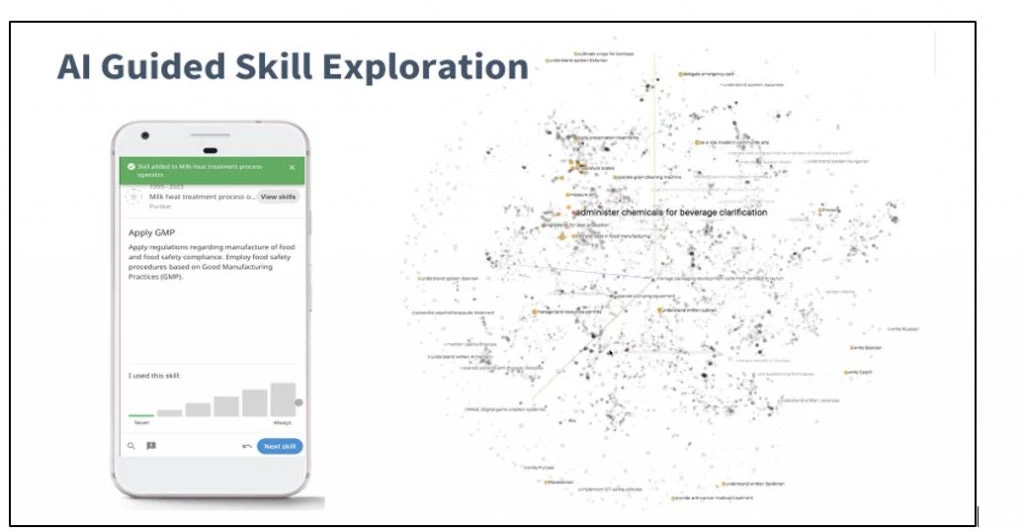 AI
AI
Artificial Intelligence (AI) has the potential to transform youth employment programs. A new IFC report includes several examples of how AI can improve access, relevance, and efficiency of youth services in emerging regions.
Research indicates that the global market for AI in learning and education is expected to expand at an annual growth rate of 38% to reach $2 billion by 2023. Shrinking of job opportunities and mobility challenges due to COVID-19 are likely to increase demand for more effective technology solutions for youth employment like training, job‒matching, access to finance, etc. The growth in rates of mobile penetration to remote areas can help increase the reach of these innovative solutions to vulnerable populations.
A recent Solutions for Youth Employment (S4YE) webinar helped identify three ways in which AI can be used to develop solutions for youth employment.
1. Holistic skill profiling and job matching
AI applications can help shift to competence-based profiling and job matching systems. A competence-based matching approach moves away from merely collecting information about a job seeker’s formal qualifications and work experience to a more holistic approach of capturing skills, life experiences, and ambitions.
Focus on competencies rather than qualifications can help uncover previously unknown practical skills, especially those learned through informal experiences. Household chores or volunteering, for example, require planning, resource management, and caregiving but are often discounted when writing CVs. Using this approach, youth‒ who often lack formal experience at the start‒ can improve confidence and better signal their capabilities to potential employers. On the other hand, with richer information on a person’s abilities, employers can better fit young candidates.
Vulnerable youth, like refugees & migrants, often struggle with traditional employment services due to lack of formal certifications, language barriers, and information asymmetry. AI-based profiling tools, such as Skillab’s mobile-phone app, can capture these youth’s competencies in their local language using a conversational ‘chatbot’ approach. The assessment engine asks multiple questions on each skill reported by youth to determine their level. Using a machine learning model, the application can predict proximate “competency clusters” for an individual within the 13,000 skills in the European Skills, Competences, Qualifications, and Occupations (ESCO) framework. The result is a rich skill profile that is automatically translated into the local language, including matches to different EU occupations.

2. Actionable insights from skill assessments
AI can also help analyze data from skills assessments to identify a youth’s skill gap and provide customized recommendations for skill development and career growth. Online education companies like Coursera and Andela, both IFC clients, use AI to analyze student test scores to deliver skilling recommendations. Other private companies like Revelo, another IFC client from Brazil, combine data from online education and job platforms to provide automatic upskilling recommendations.
The use of integrated psychometric assessment can also help identify latent talents and entrepreneurial potential of youth. For example, KnackApp uses a neural and behavior science-based game to measure 2,500 ‘micro-behaviors,’ such as active and passive decisions, reactions, or exploration. It then matches youth with appropriate skill development programs across a wide range of sectors, from sales, retail, construction, hospitality services to data science.
3. Just in time information on market trends
It’s difficult to know precisely what job skills will be needed in the future. Traditional demand assessment methods, such as industry consultations, surveys, and focus groups, are time-consuming and not always comprehensive. Adapting labor market systems to new trends and information can sometimes take up to ten years, causing countries to lag.
AI applications can help rapidly leverage unstructured data from varied sources like job postings, social media, government websites to predict jobs demand in the near future. For example, using AI, Singapore’s MyCareersFuture, a government-sponsored job‒matching platform, analyzes real-time online labor market information from multiple job boards to predict upcoming jobs and skills requirements. Having access to just in time market trends can then help education and training institutions to adapt their curriculum with the needs of employers, influence government policies and investment, and improve the overall efficiency of the workforce development system.
It is important to note that any AI integration on youth employment solution should consider labor market occupational and gender biases in data and maintain data privacy. A common challenge faced in implementing AI solutions is the lack of adequate data, especially in developing countries. Strong local partnerships between governments, academics, private sector will be critical in making these solutions effective.




Join the Conversation